First,
Slow Clap to the Mayor, and URA for this plan. It’s a great start to making the city more dense with development once again (and green development at that). This new green development conjures images of Portland
As with any re-development plan (unless you’re a sprawling city) the key is to integrate transit options other than automobile based to increase mobility into and out of your new development.*
This newest plan for Pittsburgh 26st street Smallman St Penn Ave.
I’ve talked ad-nauseum about AVR’s commuter line (although I will address the addition of another commuter line later). As a result I’ll focus more on the at-grade trolley topic as well as an oft ignored topic here in Pittsburgh
Trolley Circulator
In my mind, you wouldn’t have to do anything to the strip and it would already be a great idea for a tourist centered trolley. An at grade line on Smallman St.
As such it only makes sense that this idea would be incorporated into this riverfront plan. As written in the proposal, this line would start at the David Lawrence Convention Center and travel at grade up Smallman St. 40th St. Penn Ave 21st St. David Lawrence Convention Center
As I said before; solid idea. I also realize that this is just a proposal for the entire project and as such doesn’t go into too much detail on the transportation aspects of it. However, there are some issues that should be discussed and ironed out.
First, check out this great primer for streetcar systems over at the Transport Politic.
There have been a number of streetcar systems established in the
These and other systems have capitalized on the nostalgia aspect of trolleys. Many lines use either heritage equipment (like San Francisco ’s fleet of PCC cars) or new equipment made to look old (like TECO and Little Rock
or this
There is certainly something to be said for marketing your operation correctly and nostalgia is certainly a good way to do it. However, nothing beats ease of use and good inter-connection. I like the idea that it spans the entire length of the Strip from downtown all the way to Lawrenceville. It would be a great way for a Lawrenceville or Strip resident to get downtown or move between the neighborhoods.
However, the key question which isn’t really addressed here is; how do you get to the trolley if you’re not one of these residents? What are it’s connections? I know there is talk of another trolley circulator to Oakland Steel Plaza
Additionally how will someone from Oakland , or Hazelwood, or East Liberty or Garfield
It can be done, after all we’ve got the East Busway for the east end neighborhoods, and supposedly this commuter rail will be an option for people coming from the South, but how this will be integrated and implemented are important discussions that could make or break this operation.
The second issue is more of a practical nature. If you have one track on Smallman and one on Penn, you are creating two at grade crossings of the AVR’s commuter line should it follow its proposed route on 26th St. Two rail operations crossing at grade are more complex than a road crossing a railroad at grade. It involves more circuitry, and electronic systems to accomplish. Why do it twice within a few blocks, making redundant systems when you can do it once, on Smallman St
Overall, I'm clearly on board with this. I think it's a great idea and the Strip is a great place to do it. However, there are some issues that will have to be fleshed out before this aspect of the Riverfront plan could be implemented.
I was going to cover the additional circulator to Oakland in this post, but seems as though I am rambling and will probably cover that and the “proposed” North Hills to Hazelwood commuter line at the same time.
Next up: Water Taxi
*As an aside, that was a major failure with earlier re-development projects in the Pittsburgh



